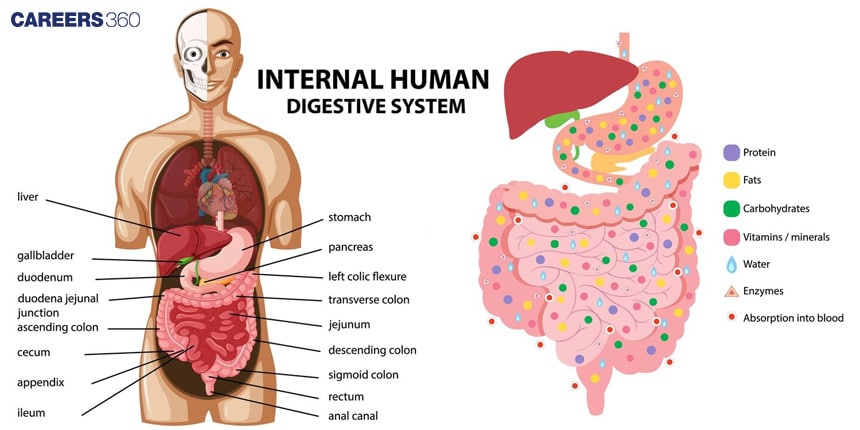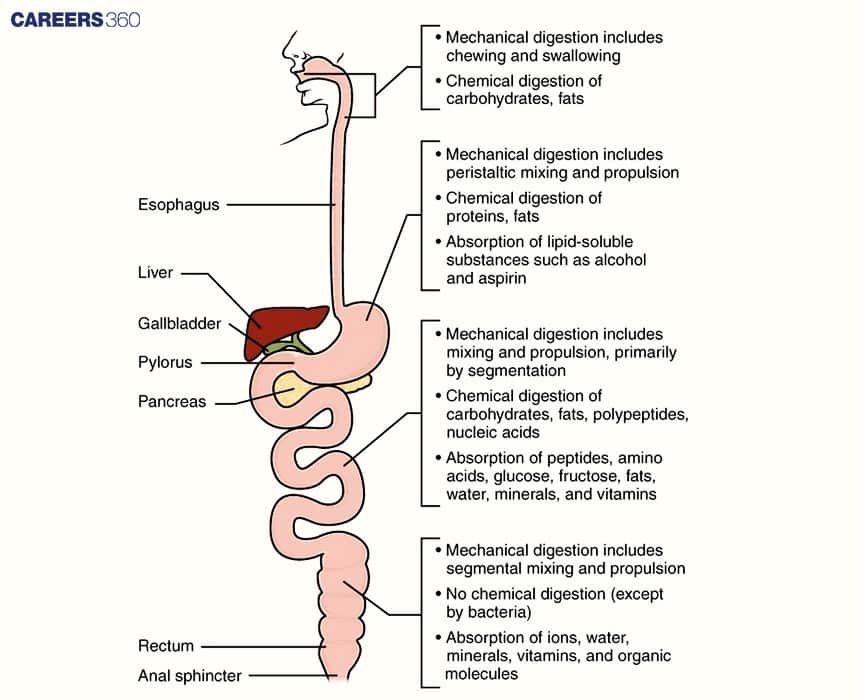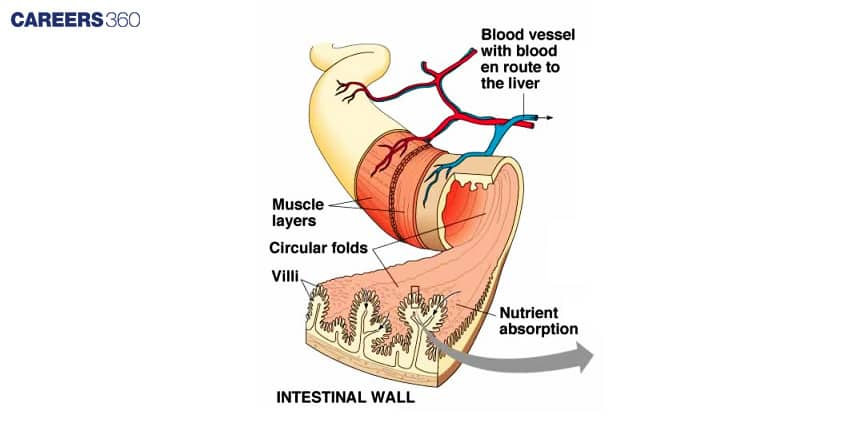Digestion And Absorption: Overview, Topics, Books, Tips, Diagrams
Digestion helps in the absorption and breakdown of food into simple nutrients that the body uses for energy, growth, and repair. The alimentary canal is about 9 metres long and includes the stomach, small intestine, and large intestine. The nutrients are absorbed in the small intestine, where the finger-like projections called the villi help in the process by increasing the surface area.
- What is the Human Digestive System?
- Stages of Digestion
- Mechanism of Digestion
- Digestive System Disorders
- Practical Implications and Applications
- Recommended Video for Digestion and Absorption
.jpg)
There are enzymes which help break down carbohydrates, proteins, and fats in compliance with the different organs like the liver, pancreas, and salivary glands. The process begins in the mouth, where chewing of the food happens, followed by absorption of nutrients in the intestine, and finally, excretion of the waste out of the body. Digestion and Absorption is an important chapter in Biology.
Important Topics of Digestion and Absorption
The chapter discusses high-scoring topics that include the human digestive system, digestive enzymes, and nutrient absorption. Studying topics helps in answering conceptual and fact-based questions correctly. Below is a list of the most important areas that you must give priority to when studying.
- Human Digestive System
- Alimentary Canal
- Digestive Glands
- Absorption of Food
- Disorder of the Digestive System
What is the Human Digestive System?
Imagine that you're having a great dinner, enjoying your food bits. But have you ever thought about exactly what happened to your food after it left your plate and passed on to your body? How food is digested within the human system is a rather interesting journey for survival. Each piece of your food intake undergoes chemical and physical changes, breaking it down into nutrients that help energise your body with all its vital functions.
Attention to the human digestive system enables one to make much better food choices and makes us appreciate the inner complexity of what goes on within us. In this article, we will look into the structure and function of the digestive system, the steps of digestion, and discuss practical applications and relevance in our daily lives.
Diagram of the Digestive System

Also Read
Major Organs in Digestion
Mouth: The mouth is the anterior opening of the digestive system. It receives food, and the types of teeth in the mouth break it down mechanically and chemically into simpler substances. Digestion in the mouth starts right from the act of chewing and partial digestion by food mixed with saliva, which is aided by the tongue, to break the carbohydrates down with salivary amylase into simpler subunits.
Oesophagus: This is a muscular tube that transports food from the mouth down to the stomach. The rhythmic muscle contraction, known as peristalsis in the oesophagus, moves the bolus to the stomach.
Stomach: A sac-like organ that churns up food and mixes it with digestive juices. The cellular lining of the stomach secretes gastric juices for the hydrolysis of proteins to chyme.
Small Intestine: This is a long tube and is the site for most digestion and absorption of nutrients. The principal area of nutrient absorption is aided by villi and microvilli in the small intestine. They are finger-like outgrowths still increasing the absorptive area.
Large Intestine: This absorbs water and produces waste products in the form of faeces. This is where the absorption of water and electrolytes occurs. It is also the site where the faeces are collected and expelled.
Rectum and Anus: These store and expel faeces.
Given below is the diagram of the various organs of the digestive system and their function.

Accessory Organs
The accessory organs are also the digestive glands that help in digestion.
Liver: The liver manufactures bile for fat digestion.
Pancreas: Secretes digestive enzymes and bicarbonate.
Salivary glands: The salivary glands help in the secretion of saliva, which has the enzymes required for the initial digestion of carbohydrates.
Gallbladder: The gallbladder stores and concentrates the bile.
Stages of Digestion
Digestion occurs in different stages—starting from ingestion in the mouth, moving through mechanical and chemical digestion in the stomach and intestines, and ending in absorption and elimination. The stages of digestion are:
Ingestion
- The digestion process starts in the mouth, where food is chewed and mixed with saliva to form a bolus.
Mixing And Movement
- Muscle contractions in the oesophagus pass the bolus into the stomach, a wave of contractions that propel food down the digestive tract in wave-like peristalsis motions.
- Additional mixing with digestive juices in the stomach breaks down the food into a semi-fluid substance called chyme.
Secretion
- Digestive enzymes, bile, and other juices are secreted by the stomach, pancreas, liver, and small intestine, which help in digestion.
Digestion
- Enzymes break down carbohydrates, proteins, and fats in the small intestine into smaller molecules.
Absorption
- Nutrients are absorbed through the walls of the small intestine into the bloodstream.
Excretion
- Absorption of water and the formation of waste products in the large intestine, followed by proper excretion of waste through the rectum and anus.
These are the steps of digestion, each of which is highly important in making food into energy and valuable nutrients. In this regard, the digestive system has become very basic not just for nutrition but also related to health and disease. Knowing about digestion makes it possible to maintain better health and prevent diseases.
Mechanism of Digestion
Food absorption generally refers to the act or process of absorption or assimilation. Absorption in biology refers to the process of absorbing or assimilating substances into the cell or across tissues and organs. Absorption of food takes place in the small intestine. The small intestine is responsible for the absorption of minerals and vitamins from food.
Some important events of Digestion are discussed below:
Process | Details |
Mouth (Mechanical) |
|
Bolus Formation |
|
Oesophagus (Peristalsis) |
|
Stomach (Chemical) |
|
Chyme Formation |
|
Duodenum (Enzyme and Bile) |
|
Small Intestine (Absorption) |
|
Large Intestine (Water) |
|
Colon (Vitamins) |
|
Waste Material |
|
Biochemical Processes of Digestion
Digestion is the process by which macromolecules are broken down into smaller molecules that will be free for absorption and utilisation within the body.
Digestion of Carbohydrates
- Digestion of carbohydrates is initiated inside the mouth, facilitated by means of salivary amylase.
- The majority of carbohydrate digestion takes place inside the small intestine.
- The important enzyme is pancreatic amylase, which yields disaccharides from starch via the means of digesting the alpha 1-four glycosidic bonds.
- The disaccharides produced (maltose, maltotriose, and α-dextrins) are all transformed to glucose via the means of brush border enzymes.
- Disaccharides don't require amylase to break them down. The enzymes (lactase, sucrase, trehalase) hydrolyse those compounds into molecules of glucose, galactose, and fructose.
Absorption of Glucose
- Glucose and galactose are absorbed throughout the apical membrane via means of secondary energetic transport (alongside Na+) via the Sodium-Glucose cotransporter (SGLT1).
- Both glucose and galactose go out of the cell through GLUT2 receptors throughout the basolateral membrane into the blood.
- Fructose enters the cell via means of facilitated diffusion through GLUT5 and is transported into the blood through GLUT2 receptors.
Digestion and Absorption of Proteins and Fats
Digestion of protein and fats takes place throughout the digestive system at different sites. Some of the major sites are discussed below:
Digestion location | Details |
Protein Digestion (Stomach) |
|
Protein Digestion (Small Intestine) |
|
Protein Absorption |
|
Fat Digestion (Small Intestine) |
|
Fat Absorption |
|
Role of Enzymes and Digestive Juices
Carbohydrates: Ptyalin in the saliva and amylopsin secreted by the pancreas react with the small intestines to degrade complex starches into monosaccharides, where monosaccharides are monomeric small sugars.
Proteins: In the stomach, the principal work of protein digestion is done by the gastric juice, namely the pepsin; then, in the small intestine, the pancreatic juice, trypsin and chymotrypsin continue protein digestion.
Fats: Fats emulsified from the bile salts are further broken down with pancreatic lipase into fatty acids and glycerol, the resultant products that can be absorbed.
Diagram: Intestinal Wall

Digestive System Disorders
Digestive disorders like acidity, constipation, ulcers, and IBS affect the efficiency of digestion and nutrient absorption. Knowing their causes and symptoms helps in early diagnosis and better management through diet, medicine, or lifestyle changes.
Vomiting is an involuntary action and is stimulated by the expulsion of food contents through the mouth from the stomach. It can be of many reasons such as food allergy, stomach infection or gastroesophageal reflux action.
Diarrhoea is a condition of abnormal bowel movement and the continuous flow of liquid-stool from the anus. Diarrhoea may be caused by many reasons such as food allergies, stomach infection, bacterial or parasitic infection in the intestinal tract.
Indigestion is the difficulty in digesting food in the stomach. It can cause pain or discomfort in the digestive system. Indigestion can be because of anxiety, food poisoning, inadequacy of digestive enzyme production in the stomach, etc.
Constipation is characterised by irregular and difficult bowel movement leads to removal of hardened faeces. Constipation may be because of indigestion of dairy foods, fat-rich content food, or by lack of water in the food.
Practical Implications and Applications
Understanding the digestive system helps in maintaining a healthy diet, managing digestive disorders, and improving overall well-being. It also supports medical and nutritional studies focused on better treatments and health practices. These are the practical implications and applications of the digestion process:
Dietary Choices
Knowing about digestion helps in choosing a diet. For example, food that is high in fibre would promote the movement of the bowels and avoid constipation.
Prevention Of Disease
Healthy digestion is known to relate to a variety of diseases, from acid reflux to IBS and Crohn's. A good diet coupled with the concept of digestion can help in their management and even in preventing them.
Medical Applications
Medical fields: In-depth knowledge of the digestion process will help to formulate treatment options against digestive disorders. For instance, supplements comprising enzymes can help individuals with insufficient functioning of the pancreas.
Nutritional Science
Nutritionists apply their digestive-system-related expertise in designing diets that are balanced and will yield maximum absorption for optimum health benefits.
Also Read:
Recommended Video for Digestion and Absorption
Frequently Asked Questions (FAQs)
Protein digestion takes place inside the belly and duodenum. Pepsin, which is secreted via means of the belly, and trypsin and chymotrypsin secreted via means of the pancreas, spoil down meal proteins into polypeptides.
The digestive enzymes are normally secreted as their inactive precursors referred to as zymogens. For example, trypsin is secreted via way of means of the pancreas inside the shape of trypsinogen, which is activated inside the duodenum via way of means of enterokinase to shape trypsin. Proteins are then broken up into smaller polypeptides by trypsin.
Bile juice is essential for digestion. It is a digestive juice that is produced via means of the liver. Even though it has no digestive enzymes, it has an important position to play in fat digestion. Bilirubin and biliverdin are the 2 bile salts that can be found in bile juice, which disintegrates big globules into smaller globules such that the pancreatic enzymes can act on them easily. This phenomenon is called the emulsification of fats. The bile juice is likewise recognized to make the medium alkaline and is concerned with the activation of lipase.
The partitions of the belly secrete hydrochloric acid, which dissolves fragments of meals and builds an acidic environment. This medium enables the conversion of pepsinogen into pepsin. Pepsin performs an important position in protein digestion.
Pepsin might be inactivated if HCl has now no longer been secreted withinside the belly which might have an impact on the digestion of proteins. To digest proteins, a pH balance of eight is necessary. HCl provides this balance.
Every tooth in humans is embedded in a socket of the jaw bone. This attachment of enamel is called codont. Most mammals and humans produce units of enamel during their lifetime. First, as a fix of milk enamel or deciduous enamel which can be transient, and 2nd a fix of grownup enamel which can be everlasting. The transient milk enamel is changed via means of everlasting grownup enamel. This dentition is called diphyodont.
Digestion may be defined because of the procedure via means of which the meals we devour pass via our bodies and is directed toward the functions of presenting the frame with electricity or constructing new mobile additives and tissues, consisting of muscle or fats. absorption of digested food takes place in the small intestine. The digested food is absorbed by the villi in the small intestine. The components of meals that the frame can not use and additionally different wastes from the frame are removed withinside the shape of excrement.
Also Read
03 Jun'25 07:18 PM
30 Nov'24 03:25 PM
26 Nov'24 05:38 PM
25 Nov'24 06:43 PM
25 Nov'24 05:45 PM
25 Nov'24 04:48 PM
25 Nov'24 03:52 PM
23 Nov'24 04:30 PM